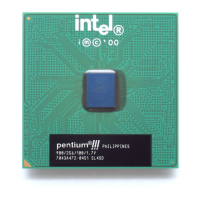Intel® Pentium® 4 Processor in the 478-Pin Package Processor Power Distribution Guidelines
R
Intel
®
Pentium
®
4 Processor / Intel
®
850 Chipset Family Platform Design Guide 197
11 Intel
®
Pentium
®
4 Processor in the
478-Pin Package Processor Power
Distribution Guidelines
11.1 Power Requirements
Intel recommends using an Intel
®
Pentium
®
4 Processor VR Down Design Guidelines-compliant
regulator for the processor system board designs that meets FMB2 requirements (refer to Section
1.6 for airflow requirements). An Intel
®
Pentium
®
4 Processor VR Down Design Guidelines-
compliant regulator may be integrated as part of the system board or on a module. The system
board designer should properly place high frequency and bulk-decoupling capacitors as needed
between the voltage regulator and the processor to ensure voltage fluctuations remain within the
Intel
®
Pentium
®
4 Processor in the 478-pin Package Electrical, Mechanical, and Thermal
Specifications and the Intel
®
Pentium
®
4 Processor with 512-KB L2 Cache on 0.13 Micron
Process EMTS. See Section 11.1.3 and 11.1.4 for recommendations on the amount of decoupling
needed.
Specifications for the processor voltage are contained in the Intel
®
Pentium
®
4 Processor with
512-KB L2 Cache on 0.13 Micron Process EMTS and the Intel
®
Pentium
®
4 Processor in the 478-
Pin Package Electrical, Mechanical and Thermal Specifications. These specifications are for the
processor die. For guidance on correlating the die specifications to socket level measurements,
refer to the socket loadlines in the Intel
®
Pentium
®
4 Processor VR Down Design Guidelines.
The voltage tolerance of the loadlines contained in the above mentioned documents help the
system designer to achieve a flexible motherboard design solution for many different frequencies
of the processor. Failure to meet the load line requirements when modeling the system power
delivery may result in a system that is not upgradeable.
Note: For maximum flexibility in system design, it is recommended to use an FMB1 or FMB2 compliant
regulator. Example regulator designs that meet FMB1 or FMB2 specifications are shown below.
Each of these designs has their benefit as well as drawbacks.
The processor requires local regulation due to its higher current requirements, and to maintain
power supply tolerance. For example, an on-board DC-to-DC converter converts a higher DC
voltage to a lower level using either a linear or a switching regulator. Distributing lower current at
a higher voltage to the converter minimizes unwanted losses (I x R). More importantly however, a
discrete regulator regulates the voltage locally, which minimizes DC line losses by reducing
motherboard resistance on the processor voltage. Figure 140 (FMB1), and Figure 141 and Figure
142 (FMB2) and shows an example of the placement of the local voltage regulation circuitry.
In this section, North and South are used to describe a specific side of the socket based on the
placement of the customer reference board shown in Figure 140 (FMB1) and Figure 141 and
Figure 142 (FMB2) and North refers to the side of the processor closest to the back panel and
South refers to the side of the processor closest to the system memory.

